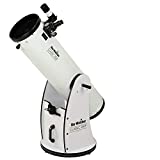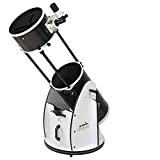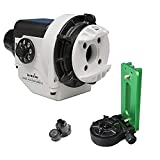Skywatcher telescopes – Buying guide & Comparison
Whether you’re just planning to buy your very first telescope or you’ve decided to upgrade your entry-level model, you’ve come to the right place. We know that finding the best Skywatcher telescope can be tedious, and you probably don’t have the time or the patience to go through a lengthy research process in order to find it. We have studied the best models on the market and, after carefully comparison and deliberation, we recommend the SkyWatcher 10” Dobsonian S11620 as the best model you can buy. It balances great features and can be found for sale at a more than affordable price. This model comes with a large 10-inch aperture, a long focal length of 47 inches, two quality eyepieces as well as other controls and accessories for unforgettable stargazing experiences. In case this model runs out of stock, then the second-best telescope you should consider is the Sky-Watcher 12″ Collapsible Dobsonian S11740.
Comparison table
 Our Top Choice
Our Top Choice
With a user-friendly design and intuitive controls, this is a great starter telescope for amateur stargazers or even for children. It can get you up close and personal with all your favorite celestial bodies. The telescope is equipped with a wide aperture of 10 inches.
The base lacks fine tuning which makes it easier to miss your target if you lean over to view in the target finder.
Overall, customers are more than satisfied with this particular model, the ease of use and nifty features making it a device that the whole family can enjoy; and it is also a great way to get your kids interested in astronomy.
 2nd Best
2nd Best
If quality is what you desire, you can’t go wrong with this premium device. It features the widest aperture among telescopes of its class. The aperture is wide enough to enable you to observe bright and detailed images of the solar system and distant nebulas and stars.
If you are a beginner, utilizing this telescope will end up becoming quite difficult as it lacks a comprehensive guide.
This telescope is ideal for seasoned stargazers that have the budget to purchase this beast. It offers excellent performance and a maximum magnification of 720x so you can see even the tiniest details of far away planets.
Also To Consider
This is a high-quality telescope full of features that also comes at a decent price. This versatile model is ideal for novices in astronomy. You can also use it for astrophotography and time-lapse photography and share your discoveries with friends.
In order to get the most out of this product, you will have to buy a few accessories which can be a bit costly.
For people on a tight budget, this is an excellent pick. It can also be bought as a gift for your kid or any student that might be interested in astronomy. The free firmware upgrades will only make it get better with each update.
Before you go on to read our Skywatcher telescope reviews, we thought that you could use a short guide to help you make the best possible purchase. We explain useful info about magnification, the field of view, as well as give some tips regarding some quality and features which should help you obtain a balance between price, usability, and quality, and ensure that you get the right telescope for your needs.
How much magnification is too much?
Many newcomers to astronomy are desperate to get the highest magnification possible in a telescope. Depending on the telescope’s build and quality of components, this can be achieved, but it won’t be cheap. In order to get huge magnification powers, you need to have a very large aperture, so that you get bright views with lots of details.
You need the latest types of coatings for light and contrast enhancement, and you also need other glass components to be of high quality.
Without these quality components and a large aperture, there isn’t a high resolution to magnify in the first place. However, you don’t need a lot of magnification, especially if you’re a beginner. With a telescope that has a 1200-mm or 47.27-inch focal length and an eyepiece of 10mm (0.3937 inches), you get a good 120x magnification, which is more than enough to study planets in our solar system up to Saturn, as well as to admire distant nebulae and galaxies.
Just so you know, the highest useful magnification for a telescope is usually 50 times its aperture in inches or 2 times the aperture in millimeters. So for a 4-inch aperture, you get to a maximum magnification of 200x.
Any more than that and distant objects will appear fuzzy, with loss of detail and unsharp edges. The quality of components and weather conditions also affect it, as lower quality glass and a hazy atmosphere will lower it.
A bit about field of view
The field of view is also important to consider before buying a telescope. Just in case you forgot, the field of view is influenced by the focal ratio of a telescope, which is its focal length divided by its aperture, as well as the eyepieces you mount. So for a 1200mm (47 inches) telescope with a 254 mm (10-inch) aperture, you get a focal ratio of f/4.7, which provides decent magnification with a wide field of view.
The wider the field of view, the more planets, stars, and galaxies you can see in one go. The narrower the field of view is, the closer objects appear, but you get to see less of the sky. For starters, a telescope with a medium focal length and a small aperture can be a good pick, since you get to explore close objects first in high detail, such as the Moon with its craters, valleys and mountains, Mars, Saturn with its amazing rings and multiple (62) moons, and Jupiter.
Complexity or ease of use?
This one will depend on your level and knowledge. If you are already accustomed to entry-level telescopes, then you can obviously go for a more complex model. However, if you’re just starting out, it would probably be better to spend a smaller amount of money on a simple telescope, learn how to align it, how to focus on distant objects, how to collimate the mirror and so on, and only later go for a more sophisticated telescope.
The more expensive a telescope, the more gadgets, buttons, and knobs appear, and you need to learn how to use them all. All these might seem overwhelming for a beginner, although learning is still possible, it’s just that the learning curve would be much steeper.
Ease of use also translates into convenience. Do you want the best telescope from Skywatcher in terms of quality? Then you’d better be prepared to spend at least half an hour mounting and dismounting it, and you can rest assured that the telescope will be heavy enough to require a car to carry. A lighter telescope is easier to carry around in a backpack and faster to set up for observations but will offer lower quality.
4 Best Skywatcher Telescopes (Reviews) in 2024
Because finding the perfect telescope can take a lot of time and effort, we have worked hard to bring you the most appreciated models on the market so that you get to choose among the very best in terms of optical and build quality, features, and price.
Contents
1. SkyWatcher S11620 Traditional Dobsonian

This telescope is equipped with a wide aperture of 10 inches which will provide you with plenty of details of close planets.
You also get a 2-inch Crayford focuser which comes with a 1.25” adapter to help you acquire fast and accurate focus. Thanks to the solid mount with Teflon bearings, you also get to enjoy a stable platform to admire the cosmos without unwanted vibrations.
With a 1200mm or 47.24-inch focal length and a focal ratio of f/4.7, this telescope is bound to get you close-ups of your favorite celestial objects. You also get to benefit from further magnification with the Super 25 and 10mm eyepieces.
Pros
This model includes a paraboloidal primary mirror that eliminates the spherical aberrations that might appear, which surely comes in handy given its powerful magnification capabilities.
Since being able to comfortably and smoothly operate the telescope is a crucial aspect during observations, this model includes a new feature-tension control handle.
The four-arm secondary mirror bracket ensures that diffraction spikes and light loss are reduced for an enhanced overall experience.
The solid mount with Teflon bearings provides a sturdy platform that you can use as you gaze at your favorite constellations and planets around the night sky.
Cons
In some rare cases, the product was delivered with missing elements, but you can contact the seller in case you face this situation.
The mount is rather heavy, so you might need some help from someone else. This particularly applies if this telescope is going to be used by kids or elderly family members.
Buy from Amazon.com
2. Sky-Watcher Collapsible Dobsonian Telescope

Its aperture is the widest among telescopes of its class, wide enough to provide you with bright, high-contrast images of our solar system as well as distant nebulae and star clusters.
Its long focal range of 1500mm or 59 inches is also great to provide you with great magnification, and the opportunity to see the tiniest details on planets up to Saturn. You get useful magnification of up to 720x but also a wide field of view, thanks to its f/5 focal ratio.
You also get 2 Plossl 25 and 10mm eyepieces as well as a solid mount with high-quality bearings, a collapsible tube design which makes it portable and easy to transport, as well as a GoTo Dobsonian base.
Pros
The large aperture the Dobsonian S11740 features is one of the key elements that make it stand apart from other telescopes in its category.
For a better overall user experience, this model is collapsible which means that you can easily store it, or transport it to other locations from where you can observe the sky.
Given that its solid mount features Teflon bearings, as well as a tension clutch, it provides a solid platform that you can rely on.
The 720x magnification and 1500mm focal length allow you to clearly see the celestial objects you are interested in.
Cons
Upon delivery, the collimation screws for the secondary mirror could be too tight, so you might need to force them a little bit loose in order to collimate it.
This unit is heavy, so this is something you should be aware of, especially if more people are going to use it.
Buy from Amazon.com
3. SkyWatcher S20510 Star Adventurer Astro Package

Thanks to its multiple pre-programmed speeds, you get to take long-exposure shots and time-lapse photos of your favorite planets and nebulae with ease. You can select between the Solar, Sidereal or Lunar tracking rate to let this mount do all the work so that you can only observe and wonder.
With its DSLR-friendly interface, you get automatic shutter release controls to trigger your camera remotely, as well as external mini USB power support.
This model also comes with a built-in polar scope with illuminator as well as unlimited free firmware upgrade to ensure that you benefit from all the new software improvements.
Pros
The DSLR interface includes an automatic shutter control that is extremely helpful as you make your precise observations and recordings.
The user-friendly design makes the Star Adventurer S20510 a very good choice for those who are less experienced but very passionate about discovering the mysteries of various celestial objects.
You can select between three different tracking rates (Solar, Lunar, or Sidereal) and then let the unit work while you take your time and observe the sky.
The unlimited free firmware upgrades included with this product ensure that you will always benefit from the latest improvements.
Cons
In some cases, this model didn’t come in the usual black color, so if you have any questions regarding the available color schemes, contact the manufacturer for additional information.
The integral polar scope doesn’t always work to best align the unit, but some users have used smartphone apps to get this done in a quick way.
Buy from Amazon.com
4. SkyWatcher S11500 Maksutov Cassegrain 90mm

With a 90mm or 3.54 aperture, this telescope is bright enough to get clear and crisp views of Earth’s natural satellite as well as other planets, while the 1250mm (49.21 inches) focal length is sure enough to get you closer to even distant celestial objects.
With a focal ratio of f/13.8, the SkyWatcher Maksutov-Cassegrain 90mm has great magnification powers and a narrow field of view, so you can focus on particular objects and study them in high detail.
All glass optics come with the usual multi-coatings which improve light transmission and contrast while also removing chromatic aberrations. You also get to easily align your telescope, thanks to the incorporated Red Dot finder.
Pros
The multi-coating layers the S11500 includes ensure an enhanced light transmission for high-quality viewings that don’t have as many chromatic aberrations but do have improved contrast.
The Red Dot finder functionality comes in handy if you want to quickly align your telescope, which works well especially since the unit is easy to use by those less experienced.
The 90mm aperture gathers enough light for you to enjoy clear images of the celestial objects you are focusing on.
The 1250mm focal length is doing a very good job in bringing planets or constellations closer so that you can see the details you are interested in.
Cons
Some of the screws might need a little bit of tightening before using the telescope for the first time, according to some reviews.
Given that this model is more of a portable one, there might be some limitations on how many deep space objects you can see.
Buy from Amazon.com











